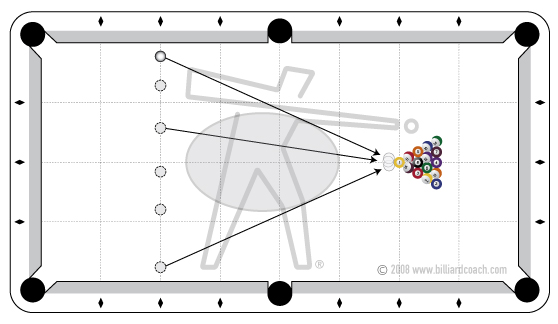Part I
© 2008 Mike Fieldhammer, BilliardCoach.com
The coin flip or lag can be a significant factor in match play. How can such an arbitrary bit of luck count for so much? The right to break the initial rack and the chance to draw first blood can be a significant advantage provided you’ve fine-tuned your breaking technique and are prepared to pounce on your prey.
Players dream about running the first rack from the break in tournament play. This tends to put pressure on your opponent to ‘hold serve’, especially in short races with an alternate break format. If your opponent gives you a shot in game two, you stand to break the third rack with a chance to move ahead three games to none. This could be an insurmountable lead for your foe to overcome. Some attention must be given to your break shot to put yourself in such a commanding position early in the match.
A successful break shot can be defined by the following description after the break:
• One or more balls have been pocketed
• The cue ball is in a position that offers an opening shot
• Object balls have scattered sufficiently and few clusters exist
The first step to a successful break is obtaining a decent rack. Worn cloth, a sub-standard triangle, mismatched object balls, a spot with a lump or divot, or dirty old object balls all make it difficult to rack tightly. An effective spread is difficult to achieve with a sloppy rack. Make an effort to see that you and your opponent rack as tightly as the equipment conditions allow.
Power and accuracy are two primary break shot stroke factors. Blended perfectly, these two factors transmit maximum energy into the stack while minimizing cue ball movement after impact. A forceful stroke delivering a full ball hit to the apex of the rack with minimum cue ball spin is optimum. Strike the cue ball as near to center ball as possible and aim to hit the head ball full. The goal is to have the cue ball rebound off the 15 ball stack and settle in the center of the table as indicated by the shaded oval in the diagram below.
The shaded cue balls illustrate the change in aim and impact based on the point of origin for the cue ball. Notice the cue ball is shown from various positions behind the head string. Different tables may break more effectively from a side of the table or angle of impact. If your favorite position isn’t pocketing balls after a few breaks, try a different spot. Also note that all of the cue ball positions shown are as close to the head string as possible. This will keep cloth friction that will slow the cue ball before impact to a minimum. It will also keep the cue ball closer to the target and aid in aiming to make the perfect full hit on the head ball.
If the cue ball contacts the head ball perfectly, the cue ball should rebound off the stack and check up in the shaded area in the middle of the table. Barring a kiss from an object ball, it will not contact a cushion. Beware of scratches in the side pockets. If your cue ball tends to move off toward one of the side rails, make a small adjustment in your line of aim. No English (sidespin) should be applied to the break shot nor any draw or follow. English will make the full hit more difficult and draw or follow bring scratches in the corners into play.
The position zone in the middle of the table will yield the most choices for an opening shot. Preferably, the cue ball has a position with multiple shots and a choice of stripes or solids. If the cue ball ends up below the stack, you’ll have fewer choices to shoot at if you’ve got a shot at all.
The first step to running racks is an effective break shot. Strive for making a ball, spreading the rack open, and controlling the cue ball to give yourself the best chance to run out. Keep these goals in mind and spend time sharpening your crucial opening shot.
See part two of this article for an alternate break which offers several advantages called the second ball break.

Leave a Reply